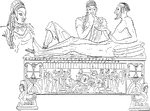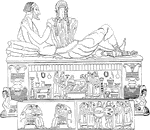Clipart tagged: ‘sarcophagus’

Sarcophagus with Canopy
This sarcophagus with canopy is sculpted in stone. The canopy is in a gothic style and on top of tomb…

Egyptian Sarcophagus
A coffin or tomb of stone; a kind of stone chest, generally more or less ornamented for receiving a…
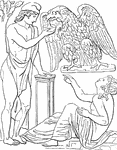
Ganymede and Eagle
"From an ancient sarcophagus, represents Ganymede giving drink to the eagle, or bird of Jobe, and Hebe…
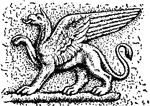
Griffin
"Griffin, from a Greek Sarcophagus. GRIFFIN. In mythology, an imaginary animal supposed to be generated…
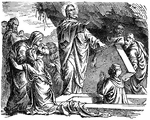
The Resurrection of Lazarus of Bethany
"And when he had thus spoken, he cried with a loud voice, Lazarus, come forth. He that was dead came…

Sarcophagus of Menkera
"The third pyramid on the ridge of Gizeh was built by Menkera, a successor of Khafra and fourth or fifth…

Mummy Coffin
An illustration of a mummy coffin. The mummy was typically wrapped in linen and placed many nesting…

Sarcophagus of Napoleon Bonaparte
An illustration of the sarcophagus of Napoleon Bonaparte located in the Church of the Hotel des Invalides.
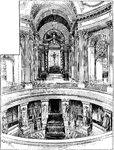
Tomb of Napoleon Bonaparte
An illustration of the tomb of the sarcophagus of Napoleon Bonaparte located in the Church of the Hotel…
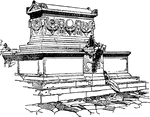
Sarcophagus
"Sarcophagus from the Street of Tombs at Assos in the Troad, excavated by the Archaeological Institute…

Ancient Egyptian Sarcophagus
A sarcophagus is a funeral receptacle for a corpse, most commonly carved or cut from stone. The word…
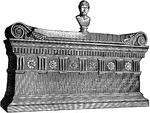
Sarcophagus of Lucius Cornelius Scipio Barbatus
An illustration of the sarcophagus of Lucius Cornelius Scipio Barbatus. Lucius Cornelius Scipio Barbatus…

Sarcophagus of Scipio
"Sarcophagus, plural Sarcophagi, is a kind of stone used among the Greeks for making coffins, and so…
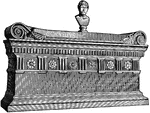
Sarcophagus of Scipio Barbatus
Sarcophagus of Lucius Cornelius Scipio Barbatus, an elected Roman consul in 298 BC.

Roman Sarcophagus Tomb
A coffin or tomb of stone; a kind of stone chest, generally more or less ornamented for receiving a…

